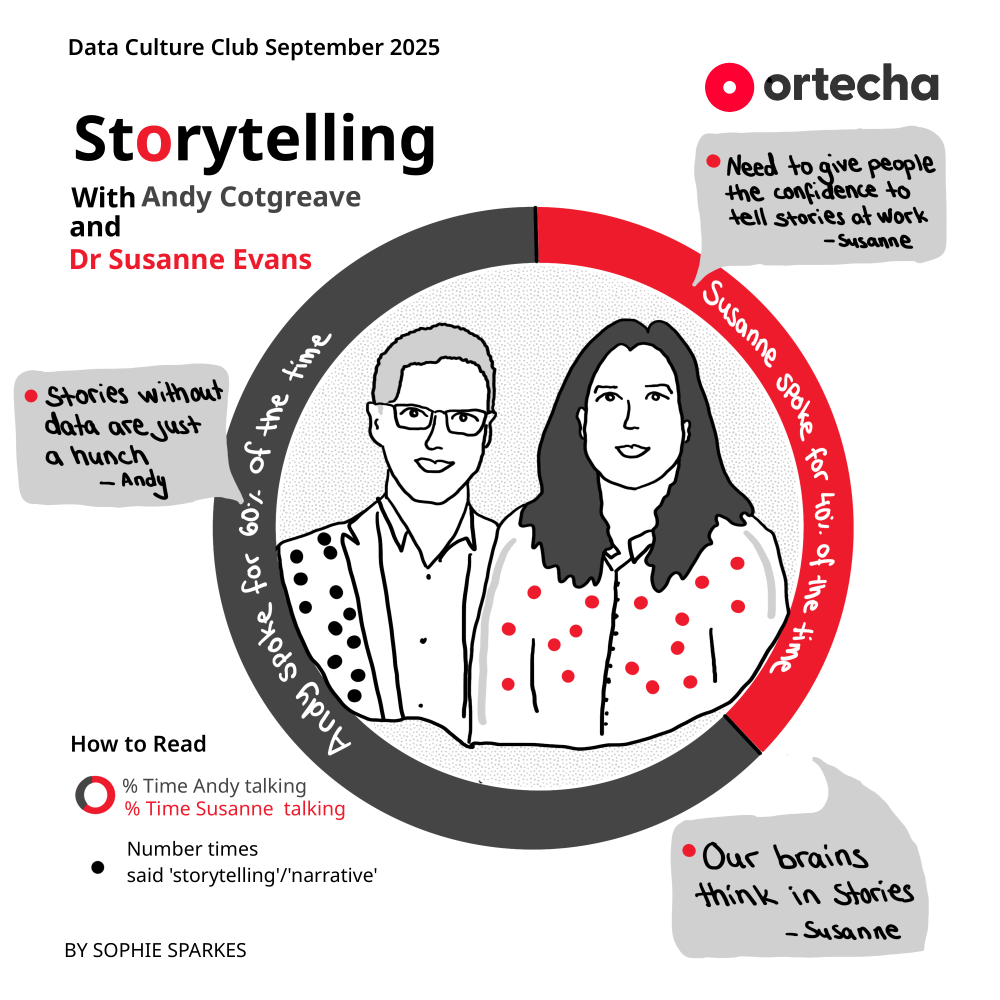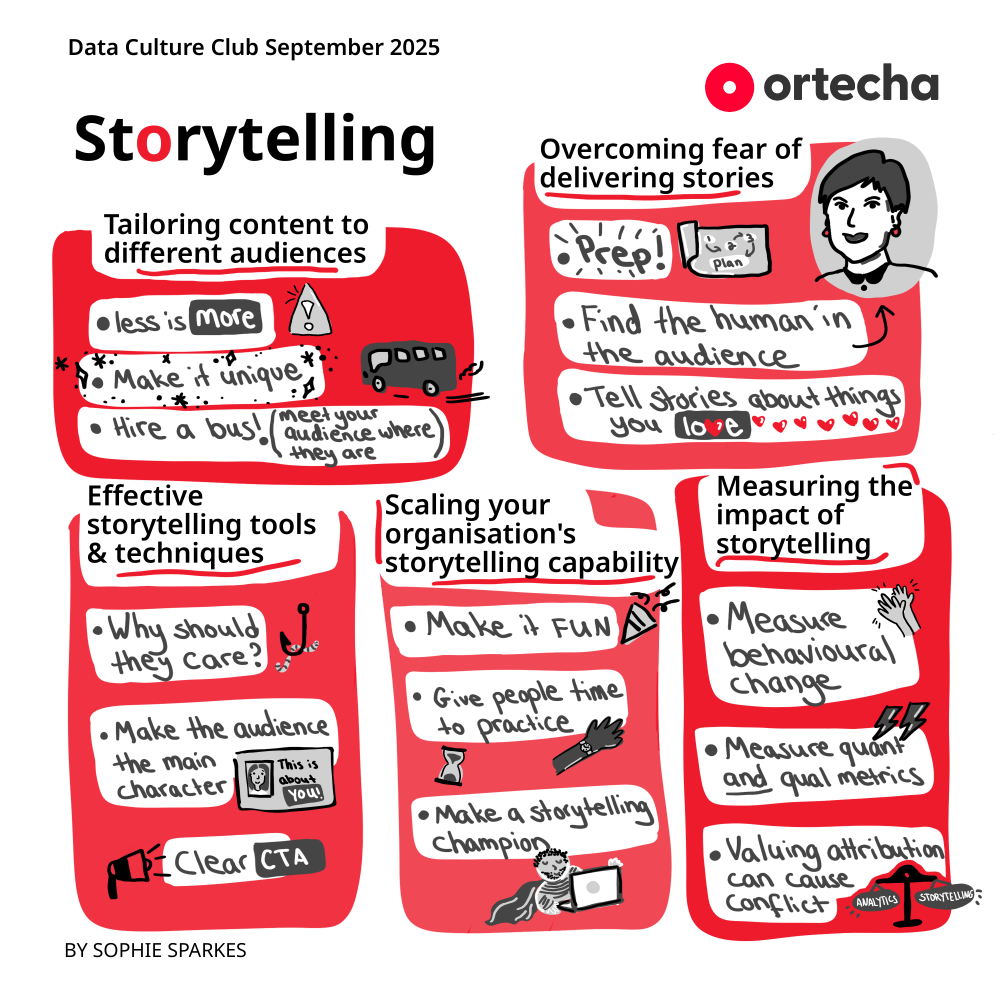At the Data Culture Club, we’ve been thinking about communication – both how to get people excited about data, and how colleagues can best present their insights – so at our latest event we took inspiration from our wonderful venue at Shakespeare’s Globe theatre to explore Storytelling.
Data isn’t just numbers, it’s narratives. The strongest data cultures aren’t built on dashboards alone, but on stories that resonate and drive decision-making at every level. But how best to get a message across to a diverse audience with different needs, concerns and learning styles? How can we add emotion to dry facts – and how can we tell if our storytelling is working?
Our members were treated to a thoughtful Fireside Chat with two experts in the field, and then explored the practicalities in a set of lively Roundtable discussions. We hope this summary of the key points from the evening inspires you to use storytelling as a tool to connect, persuade and inspire.
Fireside Chat
Our Fireside Chat brought together two expert storytellers: Dr Susanne Evans, founder of Feldspar Consulting, where she uses storytelling in organisational change, and former Tableau Chief Data Evangelist Andy Cotgreave, a leading voice in data communication.
Moderated by Ortechan Lawrence Hill and illustrated by Live Data Sketch Artist Sophie Sparkes, the conversation demonstrated that storytelling isn’t just a soft skill – it’s a strategic imperative.

Storytelling makes information meaningful and memorable
You may have noticed that when organisations are trying to do something different – maybe a merger/acquisition, or adopting a new piece of tech, or introducing a new way of working – they focus on the process, rather than the people. A leader might present some slides and a timeline at a townhall meeting, but no-one cares because it doesn’t explain how it will affect them, and no-one remembers because it’s really boring.
We see a similar sorry situation with dashboards, where organisations investing heavily in their data programmes in order to become ‘data driven’ just churn out the same old charts month after month, with no attempt to bring the information to life or make facts meaningful or memorable.
Storytelling is key to making things happen in organisations because stories are how our brains make sense of the world. Crafting a narrative around the change or the data helps us communicate with people in a way that makes it easy for them.
Data alone doesn’t drive change
The essential elements of a story
A good story has a beginning, a middle and an end. It needs a narrative arc – if you think of the great films and books, or even fairytales from childhood, there’s some kind of jeopardy that has to be overcome, or a tension that needs to be resolved. It also has to have characters, a place and a time, which are usually set at the beginning.
But what makes stories different from other forms of business communication is emotion. There’s emotion in it, but it also creates emotion in the audience. In the best stories, people will start to use their imagination to join the dots or think about their own experiences, then they’re no longer passive recipients of information, but engaged and transformed by what you’re saying.
Storytelling is key to making things happen in organisations
Finding stories to tell
You may already have some anecdotes you can share, or something you could use to illustrate a point. Analogies can be useful for bringing something quite technical or theoretical into a more familiar everyday world (like data governance being the brakes on a car or the flags on a beach). Ask questions around the office and listen actively – leaders will perhaps give you the official answer, but more casual ‘water cooler’ conversations with colleagues may tell you more.
Make a note of them, write them down so you don’t forget them, and over time you’ll build up a little library of stories you can call upon when you need them.
A word of warning – both Andy and Susanne find using AI a useful tool for generating ideas for a story, but really bad for writing them. Sometimes you just need that human connection.
Every single thing that you do in an organisation is about people
Building your confidence
Storytelling is not something that tends to be taught at university or business school (it’s somehow seen as inappropriate for the work place). But people often have better storytelling skills that they realise – after all, in the company of friends and family we often recount anecdotes about funny or interesting things that have happened to us.
And it’s not necessary to be extrovert and charismatic like a stand-up comedian to be a good storyteller. It’s more important to be authentic. Some of the best stories are told in a quiet way.
The best approach is to try it. No need to begin with “once upon a time” or “I’m going to tell you story” – just next time you have to make a presentation, try shifting into a storytelling mode for a few minutes, and notice how it feels different. It’s a good way to build confidence and experiment with new styles without any pressure.
It’s not about being the most entertaining person in the room
Honing your message
Once you’re ready to start building storytelling into the way you communicate, you can be a little more purposeful about what you say and how you say it.
Think about your audience: what they need to know, what is of interest to them, and how they like to take in information. For example, presenting at a board meeting may need to be brief and focus on the costs and benefits. Team leaders may be more interested in how day to day activities will be affected.
And think carefully about the visuals you’re sharing. Your audience will only have a few seconds to take it all in, so that dashboard you’ve been using to analyse your data will be much too detailed to share. Keep it simple, label everything, and put any deeper analysis and context in a separate document they can refer to afterwards.
And be creative – whether it’s a chart or an image, you can create an immediate emotional reaction in your audience before they’ve even consciously read what the words say.
Roundtables
After some well-earned refreshment, our members gathered into five tables to explore a different aspect of storytelling in the workplace. From tailoring content to measuring impact, participants shared practical insights, personal experiences, and bold ideas to elevate storytelling as a strategic tool for transformation.

Tailoring content to different audiences
Key takeaway: Know your audience and make it matter to them.
Table 1 explored the importance of making content relevant to an audience (so the message resonates with their motivations) and considering their channel/format preferences (to make it easy for them to consume it). However, they warned against manipulating the message – holding back from mentioning something to senior leaders, for example – it’s crucial that the core message is consistent and authentic across all audiences.
Top tips:
- Understand your audience – consider grouping them into personas or levels of seniority
- For each group, work out the best channels and format to use to connect with them (a one-to-one conversation will feel quite different from a large group presentation)
- Think about what drives your audience and why your message will matter to your them, so you can make it mean something to them
- If possible, test your story with a pilot audience to check it’s landing
- Take the message to the people, don’t wait for them to come to you (the equivalent of driving a ‘battle bus’ around the country!)
Overcoming the fear of delivering stories
Key takeaway: Preparation, passion and practice are key.
Table 2 considered the worries and fears that make people reluctant to tell stories, and discussed the best ways to build up both skills and confidence. They noted that storytelling is rooted in human connection, and conveying an idea with enthusiasm is more important than being word-perfect.
Top tips:
- Tell a story about something you’re passionate and knowledgeable about – your enthusiasm will come across as soon as you start to speak about it
- Prepare thoroughly, but don’t over-prepare
- If you’re speaking to a large group, focus on one person and speak to them – think about it from their point of view, and what they’d like to understand
- Start small and remember that your audience probably won’t even notice if it doesn’t go the way you planned – try, learn, and try again
Effective storytelling tools and techniques
Key takeaway: Use structure, emotion, and authenticity make stories stick.
Table 3 explored the anatomy of a good story – from the opening hook to the final call to action. They highlighted the importance of emotional connection and keeping the audience engaged.
Top tips:
- Use clear messaging from the start – think about your audience and what’s in it for them, why they should care, and what they need to know
- Appeal to emotion and feeling in the content – being authentic and showing your own vulnerability helps build trust and rapport with your audience
- Consider some slight theatrics in your delivery – use body language and varied tone of voice to make it interesting and engaging
- Keeping it pithy will make it more powerful – you can always provide a handout with more detail
- In closing, make it clear what the actions are so the audience has ownership and accountability to drive the change (make them feel as though they’re the hero of the story!)
Scaling storytelling capabilities across the organisation
Key takeaway: Share the knowledge and provide a safe space for experimenting.
Table 4 focused on how to turn storytelling from the preserve of a few individuals into something that everyone in the organisation can have in their skillset. From coaching to leadership modelling, they explored ways to democratise storytelling and make it part of everyday practice.
Top tips:
- Offer workshops and make them available to everybody, perhaps run by comms colleagues who already use storytelling in their work
- Make it fun and accessible, show people what good storytelling looks like, offer them techniques and templates, and give them an opportunity to practice in a safe environment.
- Appoint a storytelling champion to be responsible for encouraging take-up
- Build a community to offer support and build best practice
- Encourage your executive team to lead by example
Measuring the impact of storytelling
Key takeaway: Qualitative measurement of behaviour change is better than dashboard hits.
Table 5 tackled the tricky question of how you can tell if a story has landed, and whether you can prove that storytelling generally in your organisation is being used to good effect. They agreed that success isn’t just about reach – it’s about influence and behavioural change.
Top tips:
- Consider qualitative and quantitative measures (perhaps qualitative initially)
- Define a goal before you start measuring, and track it over time rather than seeing it as a one-off exercise
- Look for behavioural changes – for example senior leaders buying into the idea you’re conveying, or a warmer response to proposed changes
- Agree on attribution methods early to avoid conflict – after all a successful downstream change or decision may have been influenced by a story that was told several months before, and other teams will have been involved in its success
- Negative results can be a more useful data point than a positive outcome
Final takeaways
- Know your audience: Tailor your story to what they need to hear, not what you want to say.
- Balance emotion and evidence: Use data to support your narrative, not replace it.
- Be yourself: Authenticity is more important than trying to be a stand-up comedian.
- Practice and experiment: Start in a small way and build up your skill over time.
Many thanks to our guests and members for all of their fantastic ideas. We look forward to the next Data Culture Club event!

Araminta Huitson
Data Culture lead, Ortecha
Contents
- Introduction
- Storytelling makes data meaningful
- The essential elements
- Finding stories to tell
- Building your confidence
- Honing your message
- Tailoring content to different audiences
- Overcoming fear of delivering stories
- Storytelling tools & techniques
- Scaling storytelling capabilities
- Measuring the impact
- About the Data Culture Club
TALK TO AN EXPERT
Get in touch to have a chat with the team about your data culture challenges and ambitions.
Data Culture Club
A cross-industry community for an evolving discipline
Data Culture is relatively new as a concept, and still developing:
- everyone seems to have a slightly different definition of what Data Culture actually means*
- it doesn’t feature much (yet) in traditional Data Management best practice frameworks
- many companies don’t yet have dedicated teams to drive it forward
So we created the Data Culture Club, a worldwide cross-industry community to bring together the people who are leading the way in changing their organisation’s attitude to data (whether they have ‘culture’ in their job title or not), to share their successes (and failures), and to provide inspiration and support to others in the same situation.
*What we mean by Data Culture
A culture can be described as “the way things are done around here” – the shared values, attitudes and behaviours that are expressed in everyday activity.
So, a good Data Culture is one where data is a natural part of the way people work:
- everyone understands the meaning and business value of the data
- they have the tools, skills and confidence to use it
- they feel collective responsibility for looking after it
Many of our members have responsibility for Data Culture, Data Literacy, Data Enablement, Data Fluency, Data Experience or Data Adoption, or they’re a Head of Data or CDO covering Data Culture as part of a wider role.
Join the club
We hold quarterly events to allow members to meet in person, and have a thriving virtual forum for online discussion. If you work in this space, you’d be most welcome to join! Please get in touch with Araminta to learn more.

